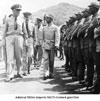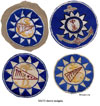|
insigne.org |
SACO (Naval Group, China) by Les Hughes ©2000 by author |
|
|
|
Collectors of naval insignia are few compared to collectors of the insignia of army units. This is not surprising given the Navy’s view of unit insignia: there are far fewer Navy insignia to collect. There are some Navy insignia, however, that surely would attract the attention of devotees of army insignia if the insignia were better known. The following describes some of these insignia and the two organizations they represent. Unusual is the collector of insignia who has not heard of the Office of Strategic Services (OSS). Indeed, so sought after are OSS-related artifacts, and so potent is the OSS cachet, that one can log onto eBay on almost any day and find items that are associated - often inaccurately - with OSS. Thus it is odd that the Naval Group, China, a Navy organization whose operations paralleled those of OSS, is today as obscure as OSS is well known. In 1942, Cmdr. Milton. E. Miles, an officer with extensive China service, was ordered by Adm. Ernest J. King, Chief of Naval Operations, to report to the American ambassador in Chungking, and there assume the position of “naval observer.” In addition to his written orders, King also imparted to Miles a set of verbal, secret orders. Miles was to establish a weather reporting network; to learn everything he could about the situation in China; to prepare the China coast for projected amphibious landings 3-4 years hence; and, in general, to do everything possible to harass the Japanese in China. To accomplish his mission, Miles forged a close working relationship with the powerful and mysterious General Tai Li, the head of a secret police/intelligence organization said to comprise 300,000 agents. Miles believed General Tai’s cooperation was essential to the success of any operations conducted on China. Miles established a close relationship with Tai in spite of the view of the State Department and U.S. intelligence community that the General was an unsavory, sinister figure. The General was never to give Miles cause to regret their alliance [1]. Many of us are prone to think of war as purely a military matter, and we are surprised when we are reminded of the importance of political considerations; we are especially surprised when politics pits ally against ally. So it was when the OSS sought to exert its influence in China. General Tai distrusted the OSS, an organization he viewed to be as political as it was military. Together, Miles and Tai proposed the formation of the Sino-American Cooperative Organization (SACO) for the purpose of training guerillas and intelligence groups, and establishing weather and radio intercept stations. American equipment would be used in these endeavors, while the Chinese would supply the lion’s share of the personnel. The Army and OSS pushed to have SACO placed under the control of General Stilwell’s headquarters. Stilwell, however, advised the Army that SACO’s mission and the relationship between Miles and Tai were such that the organization would function best if allowed to operate as it had, rather than being subject to command and control by his headquarters. The Joint Chiefs of Staff concurred. If Miles thought this episode marked the end of OSS interference, he was soon disabused of the belief. Frustrated by its inability to secure the cooperation of the Chinese without Tai’s cooperation, OSS, in a spirit of “if you can’t beat them, assimilate them,” appointed Miles the director of OSS operations in the Far East. Miles, however, refused to subordinate his mission for the Navy to OSS’s plans for China. And while he used Tai’s network of agents to report on the activities of the Japanese, Miles chose not to use those resources to compile intelligence on the Chinese themselves. OSS decided Miles had to go, and it found an ally in the American Embassy. The Navy responded with a show of support for Miles: the Navy portion of SACO was designated Naval Group, China, and Miles was appointed its commander and promoted to the rank of commodore. The accomplishments of SACO during its 40-months in China are impressive. SACO’s weather stations and forecasting service supported both the fleet and General Chenault’s 14th AAF. SACO’s 14th Naval unit, attached to the 14th AAF, provided photo interpretation and target guidance and fighter direction for Chenault’s men. SACO operated an oxygen production facility in Assam, to support flights over the “hump,” and a hospital for guerillas in the mountains Chekiang. And the unit trained guerilla units. Dr. O. P. Fitzgerald of the Naval Historical Center states, “SACO guerillas killed more Japanese and destroyed more Japanese material with a smaller expenditure of men and supplies than any other force in the Far East.” By any measure, Miles succeeded in carrying out Admiral King’s orders. And, yet, today few know of SACO. A number of SACO insignia are illustrated here, several featuring Admiral Miles’s “What the hell!” pennant. The most exotic, and among the rarest, is the jacket patch illustrating a dragon and an anchor. This was known among the men as the ‘draggin’ anchor’ patch, that being the term applied to shore-bound sailors, which SACO personnel were and, given the design of the patch, a nifty play on words. SACO insignia were made in theater, and in my opinion, given the history of the unit, they are as desirable as any army insignia of the period. Scouts & Raiders Among the specialized personnel Miles desired as part of SACO were amphibious commandos, called Scouts and Raiders. Training of the Scouts and Raiders was conducted at Little Creek, Virginia, or at Ft. Pierce, Florida. There the Scouts and Raiders, considered to be the forerunners of the SEALs, acquired the skills of amphibious commandos. Among the Theaters where Scouts and Raiders saw service were the Mediterranean, where they were used to reconnoiter beaches in advance of amphibious assaults, and the CBI. According to one source [2] a force of 750 Scouts and Raiders was authorized for the CBI Theater, where it was to serve as part of SACO. It is not clear how many of the 750 Scouts and Raiders authorized for SACO actually arrived in Theater, but at least 150 did. Some of the Raiders were able to enter China, where they trained and led bands of Chinese commandos, as did components of OSS. Other Raiders found themselves stuck in India, at Camp Knox, stranded because of inter-service friction with the Army, which controlled transport into China. Eventually, some of the Raiders were tapped to man truck convoys for the dangerous overland trip into China. The veteran from whom the Roger patch illustrated here was acquired wrote: “There were 3 Roger groups trained at the Scout and Raider Camp, next to the Underwater Demolition Camp in Ft. Pierce, Florida: Roger I, II, and III. My service was with of Roger II... We began a 3-month training in Dec. 1944: six weeks Scouts & Raider and six weeks of beach demolition. There were 8 to 10 crews in Roger II. Each crew had one officer and 6 enlisted men. We were then sent to Camp Knox, outside Calcutta, India, to wait to go into China. We stayed at Camp Knox for about 6 months, serving as Shore Patrol and guarding the brig at the camp. About one-half of Roger II drove the ‘first Navy truck convoy’ over the Stilwell Road...” Although he could not recall exactly where he had acquired his patch, he thought it was while he was at Camp Knox. The patch is fully embroidered on what appears to be a portion of a khaki shirt. The design that inspired the patch is apparently one that was well known to the Scouts and Raiders, as a sign bearing identically the same design hung at the entrance to their training facility at Ft. Pierce (see photo). One former Raider states that the code designation for the Scouts and Raiders was Amphibious Roger, which, presumably, is the origin of the name Roger. References 1. Barton, Charles, Capt. USN (Ret), "The Rice Paddy Navy," The Retired
Officer, Jan. 1989.
|


